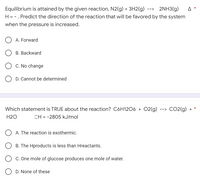
Introduction to Chemical Engineering Thermodynamics
8th Edition
ISBN: 9781259696527
Author: J.M. Smith Termodinamica en ingenieria quimica, Hendrick C Van Ness, Michael Abbott, Mark Swihart
Publisher: McGraw-Hill Education
expand_more
expand_more
format_list_bulleted
Question

Transcribed Image Text:A
Equilibrium is attained by the given reaction, N2(g) + 3H2(g) --> 2NH3(g)
H = -. Predict the direction of the reaction that will be favored by the system
when the pressure is increased.
A. Forward
B. Backward
C. No change
D. Cannot be determined
-->
CO2(g) +
Which statement is TRUE about the reaction? C6H12O6 + O2(g)
H2O
OH = -2805 kJ/mol
A. The reaction is exothermic.
B. The Hproducts is less than Hreactants.
C. One mole of glucose produces one mole of water.
D. None of these
*
*
Expert Solution
This question has been solved!
Explore an expertly crafted, step-by-step solution for a thorough understanding of key concepts.
Step by stepSolved in 2 steps

Knowledge Booster
Similar questions
- Using Le Chatilier's Pronciple to predict whether adding some HClO (aq) causes the system to shift in the direction to products or reactions: HClO + H20= H20+ ClOarrow_forwardPlease make sure it is correct and it has the significant digits.arrow_forwardPlease answer ALL parts of the question and show your work. Consider this reaction: N2(g) + 3H2(g) <------> 2NH2(g) H= -123kJ Describe how the concentration of H2 will be affected by each of the following changes to the system at equilibrium. Will it increase, decrease, or not change? (a) The volume of the reaction chamber is decreased (b) Helium gas is added to the reaction chamber (c) The temperature is increased (d) N2 has is added to the reaction chamberarrow_forward
- Consider the following reaction where K. = 1.29×102 at 600 K. COCI2(g) CO(g) + Cl2(g) A reaction mixture was found to contain 0.109 moles of COC1,(g), 2.19x10 2 moles of CO(g), and 3.88x102 moles of Cl,(g), in a 1.00 liter container. Is the reaction at equilibrium? If not, what direction must it run in order to reach equilibrium? The reaction quotient, Qe, equals The reaction A. must run in the forward direction to reach equilibrium. B. must run in the reverse direction to reach equilibrium. C. is at equilibrium.arrow_forwardConsider the following reaction: 4PC13(g) P4(g) + 6C12(g) If the initial concentration of PC13(g) is 1.5 mol/L, and "x" is the equilibrium concentration of Pa(g), what is the correct equilibrium relation а. Кс-бх7 O b. Kc=6x7/(1.0-4x)4 O c. Kc=(x)(6x)6/(1.0-4x)4 O d. Kc=(x)(6x)°/(1.5-4x)4 O e. Kc=x'/(1.0-x)4arrow_forwardThis is the problem from the textbook (at the end of bioenergenic chapter) but has no explanation.. can you please explain this problem?arrow_forward
arrow_back_ios
arrow_forward_ios
Recommended textbooks for you
 Introduction to Chemical Engineering Thermodynami...Chemical EngineeringISBN:9781259696527Author:J.M. Smith Termodinamica en ingenieria quimica, Hendrick C Van Ness, Michael Abbott, Mark SwihartPublisher:McGraw-Hill Education
Introduction to Chemical Engineering Thermodynami...Chemical EngineeringISBN:9781259696527Author:J.M. Smith Termodinamica en ingenieria quimica, Hendrick C Van Ness, Michael Abbott, Mark SwihartPublisher:McGraw-Hill Education Elementary Principles of Chemical Processes, Bind...Chemical EngineeringISBN:9781118431221Author:Richard M. Felder, Ronald W. Rousseau, Lisa G. BullardPublisher:WILEY
Elementary Principles of Chemical Processes, Bind...Chemical EngineeringISBN:9781118431221Author:Richard M. Felder, Ronald W. Rousseau, Lisa G. BullardPublisher:WILEY Elements of Chemical Reaction Engineering (5th Ed...Chemical EngineeringISBN:9780133887518Author:H. Scott FoglerPublisher:Prentice Hall
Elements of Chemical Reaction Engineering (5th Ed...Chemical EngineeringISBN:9780133887518Author:H. Scott FoglerPublisher:Prentice Hall
 Industrial Plastics: Theory and ApplicationsChemical EngineeringISBN:9781285061238Author:Lokensgard, ErikPublisher:Delmar Cengage Learning
Industrial Plastics: Theory and ApplicationsChemical EngineeringISBN:9781285061238Author:Lokensgard, ErikPublisher:Delmar Cengage Learning Unit Operations of Chemical EngineeringChemical EngineeringISBN:9780072848236Author:Warren McCabe, Julian C. Smith, Peter HarriottPublisher:McGraw-Hill Companies, The
Unit Operations of Chemical EngineeringChemical EngineeringISBN:9780072848236Author:Warren McCabe, Julian C. Smith, Peter HarriottPublisher:McGraw-Hill Companies, The

Introduction to Chemical Engineering Thermodynami...
Chemical Engineering
ISBN:9781259696527
Author:J.M. Smith Termodinamica en ingenieria quimica, Hendrick C Van Ness, Michael Abbott, Mark Swihart
Publisher:McGraw-Hill Education

Elementary Principles of Chemical Processes, Bind...
Chemical Engineering
ISBN:9781118431221
Author:Richard M. Felder, Ronald W. Rousseau, Lisa G. Bullard
Publisher:WILEY

Elements of Chemical Reaction Engineering (5th Ed...
Chemical Engineering
ISBN:9780133887518
Author:H. Scott Fogler
Publisher:Prentice Hall


Industrial Plastics: Theory and Applications
Chemical Engineering
ISBN:9781285061238
Author:Lokensgard, Erik
Publisher:Delmar Cengage Learning

Unit Operations of Chemical Engineering
Chemical Engineering
ISBN:9780072848236
Author:Warren McCabe, Julian C. Smith, Peter Harriott
Publisher:McGraw-Hill Companies, The